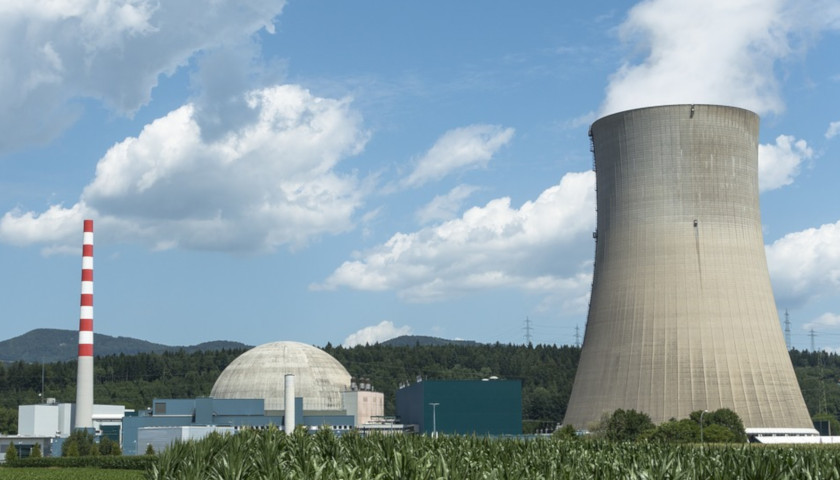by Kevin Killough
As the world looks for ways to decarbonize energy while keeping energy costs down, nuclear power is getting a second look. But the costs and construction times to build nuclear reactors in the United States raises the risk America may get left behind.
Concerns about the impacts of climate change drove some nations, such as Germany, to pursue a transition from fossil fuels using primarily wind and solar. Researchers such as Mark Z. Jacobson produced studies that claimed the U.S. could achieve 100 percent of its energy needs from wind, solar and hydroelectric without any fossil fuels or nuclear.
While 100% renewable worked well in a study, it performed poorly in practice. The U.S. and European nations built out their wind and solar portfolios, and utility bills began to climb rapidly. A charity in the United Kingdom this month warned that 2 million residents could have their electricity cut off this winter because they can’t afford their bills.Germany shut down its last three nuclear power plants in April. The nation was once Europe’s economic powerhouse, but over the past year its economy has stagnated as industries crumble beneath the weight of the country’s high energy costs.
California leads the nation in renewables, and energy costs are so high that the state passed laws to base utility bills on customers’ income levels to try and ease the pain to lower income residents. This comes as diminishing electricity supplies are threatening grid reliability.
Nuclear energy is now getting some traction in the energy discussion as the world seeks a better way to decarbonize the energy without crushing economies. At the COP28 climate summit in Dubai last year, 22 nations signed a pledge promising to triple their nuclear capacity by 2050.
France is considering that it will need to build 14 new nuclear power plants to reach its energy transition goals.
The International Energy Agency estimated in a report released this month that the nuclear comeback will drive record-high electricity production from nuclear power in 2025.
American costs
The U.S. is also showing signs it’s onboard with this nuclear renaissance.
California’s Diablo Canyon nuclear power plant was slated to close as anti-nuclear activists convinced the state the industry was too dangerous to continue operating. Despite the protests, the Nuclear Regulatory Commission in December accepted the application for the plant to continue operation.
The U.S. Department of Energy Wednesday handed an energy company a $1.5 billion conditional loan to help it restart the Palisades nuclear power plant in Michigan.
There have been problems with America’s recent nuclear development. In November, Portland-based NuScale announced the cancellation of its pioneering small modular reactor (SMR) project, citing delays and escalating costs. The project would have been the nation’s first SMR power plant, which are advanced nuclear reactors with a power capacity of around 300 megawatts per unit. This is about one-third the amount of a conventional reactor.
Developing nuclear energy in the U.S. is expensive — the world’s most expensive according to one analysis. Sam Dumitriu and Ben Hopkison, researchers at Britain Remade, an organization that promotes British economic improvement, found that it cost $8.03 million per megawatt on average to construct a nuclear power plant in the U.S. That’s compared to $1.76 million in South Korea and $4.43 million in France.
Among 18 nuclear power plants built around the world, the Vogtle 3 and 4 units in Georgia were the most expensive, according to the analysis. According to data researcher Hannah Ritchie, construction times for nuclear reactors across the world show that India is the only nation with longer average construction times longer than the U.S.
Energy expert Robert Bryce told Just The News that the price of natural gas in Europe is driving interest in nuclear energy in Europe. Natural gas future prices at Europe’s benchmark trading hub were four times higher this week than the Henry Hub prices in the U.S, and European gas prices have seen considerable declines over the past year. “For utilities in Europe, nuclear is a much more competitive, much more economic move than it is for utilities here in the United States,” Bryce said, especially when you consider the “stratospheric” costs to permit and build nuclear reactors in the U.S.
And because of the war in Ukraine, there’s a lot more concerns in Europe about natural gas supply disruption that are tied up in geopolitical situations, whereas the U.S. is producing so much natural gas, it’s the world’s largest exporter. “All of those factors together, indicate to me that Europe is going to move faster than the US will in deploying new nuclear,” Bryce said.
Batman
It’s hard to predict if the growing support for nuclear energy will continue. In the U.S., public support of nuclear energy dropped after the 1979 Three Mile Island incident. Though the accident caused no deaths or injuries, it coincidentally followed the release of “The China Syndrome,” a popular fictional thriller about a safety crisis at a nuclear power plant in California.
Then in the 1980s, the Chernobyl disaster added to perceptions that the industry is unsafe. Though there is considerable debate over the long-term death toll, the official immediate death count is 31. The 2011 Fukushima accident, which resulted in no deaths but caused the evacuation of thousands in Japan, also lowered public opinion about nuclear energy.
Nuclear advocate Jenifer Avallaneda Diaz — known as Nuclear Hazelnut on X — told Just The News that when people judge the industry by these isolated accidents, it’s a lot like judging the safety of cruises by the Titanic disaster or the safety of air travel by plane crashes.
By day, Diaz is a risk analysis engineer at Westinghouse, and by night, she tries to engage people with concerns about nuclear energy in hopes, she said, of changing their perspective.
“It’s like Batman,” Diaz joked.
Many designs
The nuclear renaissance is being helped with the excitement over advanced nuclear reactors, which includes small nuclear reactors and microreactors. Microreactors generate up to 20 megawatts of thermal energy. The smaller designs of SMRs and microreactors allow for a number of advantages, including a lower upfront capital investment.
The development, permitting and construction of advanced nuclear reactors in the United States is slow and very expensive, Diaz said, but that goes with the territory of developing new technologies. “That happens with the iPhone, the computer, with the laptops. And so it happens. It takes time. The good thing is that there are many companies behind this race,” Diaz said.
Indeed, as shown in the Advanced Reactors Information System (ARIS), there are dozens of different designs in various stages of development in various countries. These designs use different cooling systems and different fuels.
Diaz said that once a certain design has received approvals, it gets easier to permit and build reactors with that design. “Not almost anyone wants to be the first one. They want to be the second one,” Diaz said.
With nuclear energy enjoying bipartisan support in the U.S., the prospect for nuclear permitting reform looks a lot brighter. President Joe Biden in June, as part of the Fiscal Responsibility Act of 2023, signed into law environmental review reforms for nuclear permitting, which are expected to speed up one aspect of the process.
Resonating
Diaz is not the only nuclear advocate gaining traction with public opinion.
Madi Hilly, founder of the Campaign For a Green Nuclear Deal, posted a thread on X in 2022 dispelling concerns about the safety of nuclear waste, which received considerable response. A recent poll by the Pew Research Center showed a steady annual increase in support for nuclear power— highest among Republicans — with the exception of a dip in 2020, since 2016.
However, as Three Mile Island, Chernobyl, and Fukushima show, it takes one high-profile accident — even one that causes no deaths or injuries — to turn opinions. Diaz said her approach to advocating for nuclear power is producing results. She said, instead of trying to browbeat people who oppose energy, she tries to give them room to disagree while providing her own knowledge of the issue.
“Hey, I am someone working in the industry with some experience. Let me share what I know,” Diaz said of her approach to engaging nuclear critics.
She said a state representative in Michigan recently contacted her about creating a nuclear innovation bootcamp for students and career professionals to spend a couple weeks learning about the industry. She added that people concerned about energy-related environmental damage were particularly receptive.
“‘My goodness,’ they say, ‘we’re fighting for the same issue.’ So it has been growing, especially with younger generations,” she said.
– – –
Kevin Killough is an investigative reporter at Just the News.








